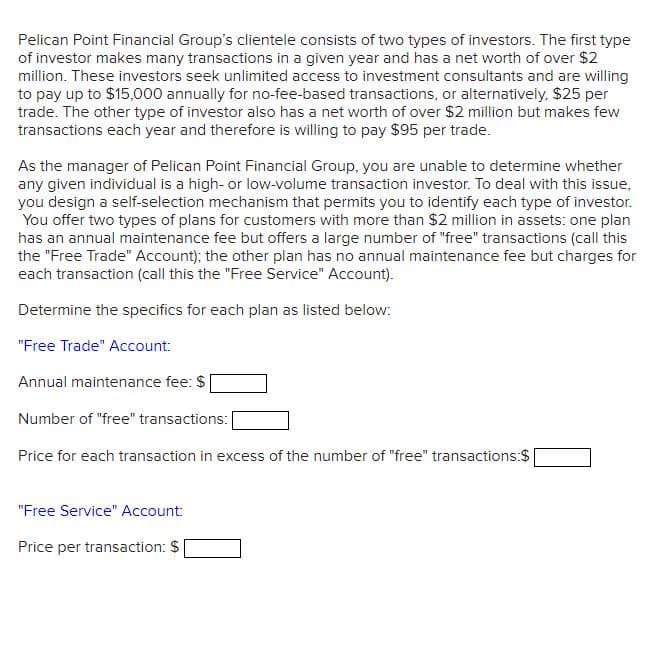Pelican Point Financial Group's clientele consists of two types of investors. The first type of investor makes many transactions in a given year and has a net worth of over $2 million. These investors seek unlimited access to investment consultants and are willing to pay up to $15,000 annually for no-fee-based transactions, or alternatively, $25 per trade. The other type of investor also has a net worth of over $2 million but makes few transactions each year and therefore is willing to pay $95 per trade. As the manager of Pelican Point Financial Group, you are unable to determine whether any given individual is a high- or low-volume transaction investor. To deal with this issue, you design a self-selection mechanism that permits you to identify each type of investor. You offer two types of plans for customers with more than $2 million in assets: one plan has an annual maintenance fee but offers a large number of "free" transactions (call this the "Free Trade" Account); the other plan has no annual maintenance fee but charges for each transaction (call this the "Free Service" Account). Determine the specifics for each plan as listed below: "Free Trade" Account: Annual maintenance fee: $ Number of "free" transactions: Price for each transaction in excess of the number of "free" transactions:$ "Free Service" Account: Price per transaction: $
Pelican Point Financial Group's clientele consists of two types of investors. The first type of investor makes many transactions in a given year and has a net worth of over $2 million. These investors seek unlimited access to investment consultants and are willing to pay up to $15,000 annually for no-fee-based transactions, or alternatively, $25 per trade. The other type of investor also has a net worth of over $2 million but makes few transactions each year and therefore is willing to pay $95 per trade. As the manager of Pelican Point Financial Group, you are unable to determine whether any given individual is a high- or low-volume transaction investor. To deal with this issue, you design a self-selection mechanism that permits you to identify each type of investor. You offer two types of plans for customers with more than $2 million in assets: one plan has an annual maintenance fee but offers a large number of "free" transactions (call this the "Free Trade" Account); the other plan has no annual maintenance fee but charges for each transaction (call this the "Free Service" Account). Determine the specifics for each plan as listed below: "Free Trade" Account: Annual maintenance fee: $ Number of "free" transactions: Price for each transaction in excess of the number of "free" transactions:$ "Free Service" Account: Price per transaction: $
Managerial Economics: Applications, Strategies and Tactics (MindTap Course List)
14th Edition
ISBN:9781305506381
Author:James R. McGuigan, R. Charles Moyer, Frederick H.deB. Harris
Publisher:James R. McGuigan, R. Charles Moyer, Frederick H.deB. Harris
Chapter1: Introduction And Goals Of The Firm
Section: Chapter Questions
Problem 1.6CE
Related questions
Question

Transcribed Image Text:Pelican Point Financial Group's clientele consists of two types of investors. The first type
of investor makes many transactions in a given year and has a net worth of over $2
million. These investors seek unlimited access to investment consultants and are willing
to pay up to $15,000 annually for no-fee-based transactions, or alternatively, $25 per
trade. The other type of investor also has a net worth of over $2 million but makes few
transactions each year and therefore is willing to pay $95 per trade.
As the manager of Pelican Point Financial Group, you are unable to determine whether
any given individual is a high- or low-volume transaction investor. To deal with this issue,
you design a self-selection mechanism that permits you to identify each type of investor.
You offer two types of plans for customers with more than $2 million in assets: one plan
has an annual maintenance fee but offers a large number of "free" transactions (call this
the "Free Trade" Account); the other plan has no annual maintenance fee but charges for
each transaction (call this the "Free Service" Account).
Determine the specifics for each plan as listed below:
"Free Trade" Account:
Annual maintenance fee: $
Number of "free" transactions:
Price for each transaction in excess of the number of "free" transactions:$
"Free Service" Account:
Price per transaction: $
Expert Solution
This question has been solved!
Explore an expertly crafted, step-by-step solution for a thorough understanding of key concepts.
This is a popular solution!
Trending now
This is a popular solution!
Step by step
Solved in 3 steps

Knowledge Booster
Learn more about
Need a deep-dive on the concept behind this application? Look no further. Learn more about this topic, economics and related others by exploring similar questions and additional content below.Recommended textbooks for you

Managerial Economics: Applications, Strategies an…
Economics
ISBN:
9781305506381
Author:
James R. McGuigan, R. Charles Moyer, Frederick H.deB. Harris
Publisher:
Cengage Learning


Managerial Economics: Applications, Strategies an…
Economics
ISBN:
9781305506381
Author:
James R. McGuigan, R. Charles Moyer, Frederick H.deB. Harris
Publisher:
Cengage Learning
